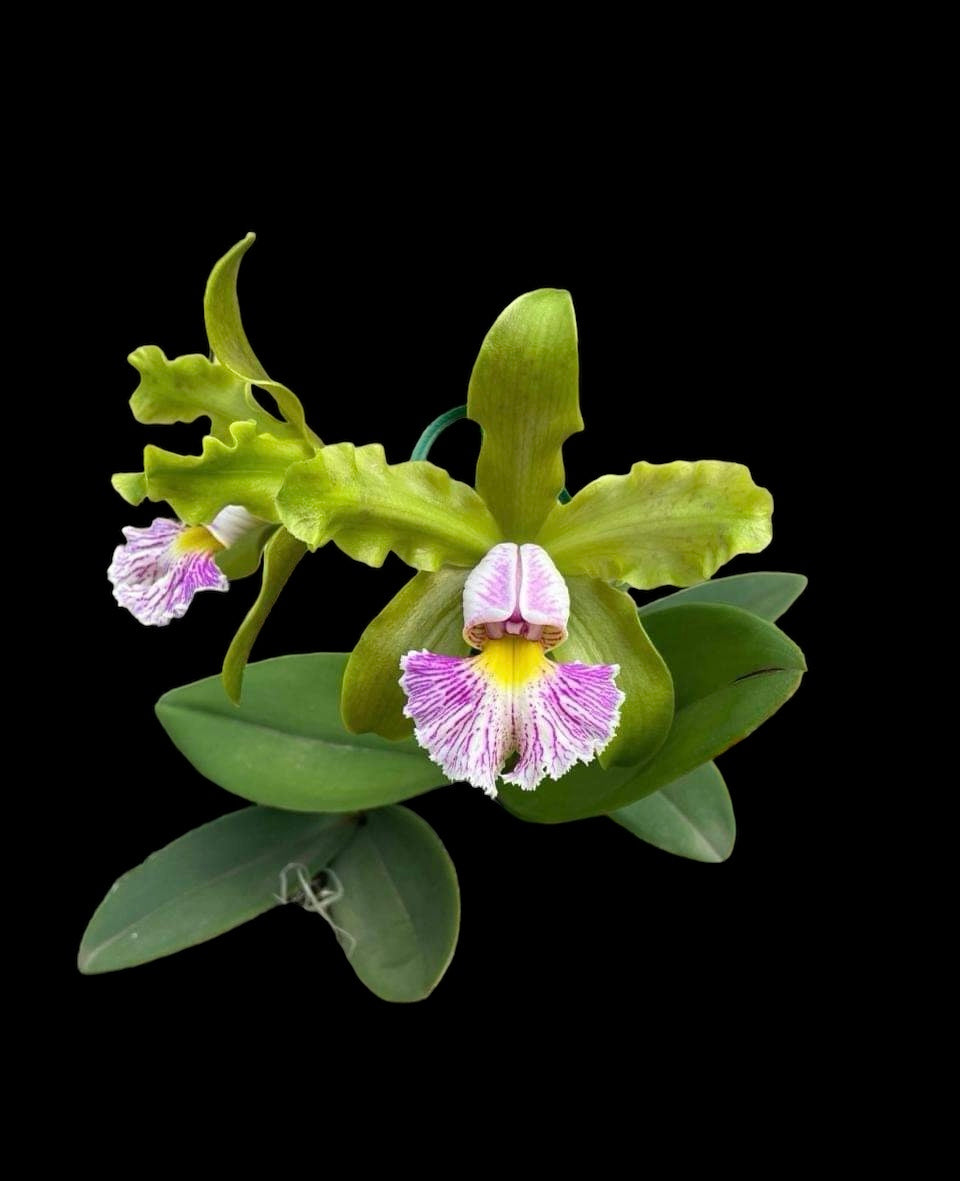
Very large mature specimen plants on cork as shown (Tested virus clean)
Cattleya schilleriana is one of the most under-appreciated gems of the Cattleya Alliance, if not the entire orchid family. It is a small-growing member of the bifoliate tribe of cattleyas, which have two leaves on each pseudobulb. Mature plants of C. schilleriana are approximately 10 inches tall, individual flowers are about 4 inches across and there may be four to six flowers per inflorescence on a well-grown plant.
The flowers are deliciously fragrant, waxy and have a high sheen. Petals and sepals, in varying shades of tan, brown and mahogany are overlaid with much more intensely colored spots. Perhaps the most striking feature of all is the lip, which is white with rich magenta stria-tions. On good specimens, it is perfectly flat and 2 inches across. This brilliant rich lip garners attention, even from across the showroom floor, and invites viewers to come and investigate. Upon closer inspection, you notice the wonderful fragrance, glossy sheen, exotic spotting and abundance of flowers.
I like to describe C. schilleriana to my friends as a new and improved Cattleya aclandiae. Cattleya schilleriana has dramatically more flowers per inflorescence than does C. aclandiae (four to five versus one to two) and the individual flowers are somewhat larger (4 inches versus 3 inches). Their fragrance is headier and more penetrating and the striations of the lip come out and grab you in a way that the solid-colored lip of C. aclandiae does not. The flowers on C. schilleriana last for approximately three to four weeks, which is about twice as long as for those of C. aclandiae. Cattleya schilleriana is much easier to grow than C. aclandiae, which must be grown on a mount and has a rightfully deserved reputation as being finicky. Cattleya schilleriana grows well in a pot and is no more difficult to cultivate than the average bifoliate cattleya.
Although initially discovered in 1857, plants of this species were uncommon in cultivation prior to the mid 1970s. One reason for this may be their extreme rarity in nature. They are apparently found only along two or three streams in a small area of Brazil. Beginning in the 1970s, a number of plants were imported from Brazil. Although it is still not common in collections, a number of growers now sell seedlings grown from these original imports.<head><meta charset="UTF-8" /></head>
CULTURE FOR THIS CATTLEYA
New growths emerge in early spring and blooming occurs after the growths mature in April through June. Generally, new roots do not emerge until immediately after flowering. In cultivation, it is not uncommon for plants to send up another growth or two during the summer. Infrequently, these summer growths will bloom over summer and autumn as they mature, but it is more typical that these growths will never flower. The plant appears to go into a dormant stage during autumn and early winter until new growths appear again in late winter or early spring.
Temperature
Cattleya schilleriana basically grows well under conditions provided for cattleyas. The temperature range in its native habitat is apparently a little on the cool side of standard cattleya conditions. Summer temperatures never climb above the low 80s and winter temperatures fall as low as 46 F. Therefore, it might be advisable to look for a slightly cooler than average spot in the cattleya house, particularly during winter. Cattleya schilleriana grows well for me in a greenhouse where winter temperatures drop to 60º F at night. For many years I successfully grew equally good specimens under lights in my home, where evening temperatures were higher and there was little temperature drop in the evenings.
Watering
In its native habitat, there are four dry months during the summer when there is no rain, corresponding to June through September in the Northern Hemisphere. All of autumn and winter is somewhat rainy. Then the true rainy season begins in the spring. The plants begin their new growths and flower during the rainy season. Although there is no rain during the summer, the dews are extremely heavy, so that there is no extremely dry season for these plants in nature when they completely dry out.
Most successful growers of this species seem to grow their plants a little on the dry side during the autumn and winter. When plants are actively growing in spring and summer, they are given more water.
My experience has been that plants are larger and more robust when grown in containers, rather than on mounts. In order to allow them to dry out properly between waterings, pot in a porous medium such as plain medium fir bark. Do not attempt to grow this species in peat-based mixes. It may be that using a clay pot is also a good idea, but the most important thing is to use a porous mix such as plain medium-grade fir bark. For plants in 5- and 6-inch pots, I use clay and plastic interchangeably. However, for mature specimens in larger containers, I always use cla
Returns Policy
Due to the delicate nature of our orchids, all of our products may not be returned. If you're unhappy with your purchase, please contact orders@orchidclassics2u.com with your order number and reason for dissatisfaction with your order. We will do our very best to ensure you're happy with your Orchid Classics shopping experience.
Shipping
We can ship to virtually any address in the world. Note that there are restrictions on some products, and some products cannot be shipped to international destinations.
When you place an order, we will estimate shipping and delivery dates for you based on the availability of your items and the shipping options you choose. Depending on the shipping provider you choose, shipping date estimates may appear on the shipping quotes page.






